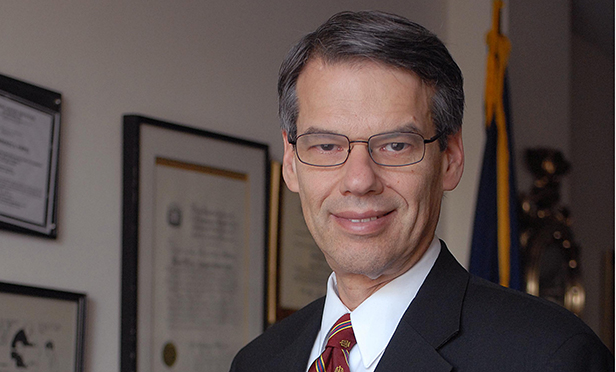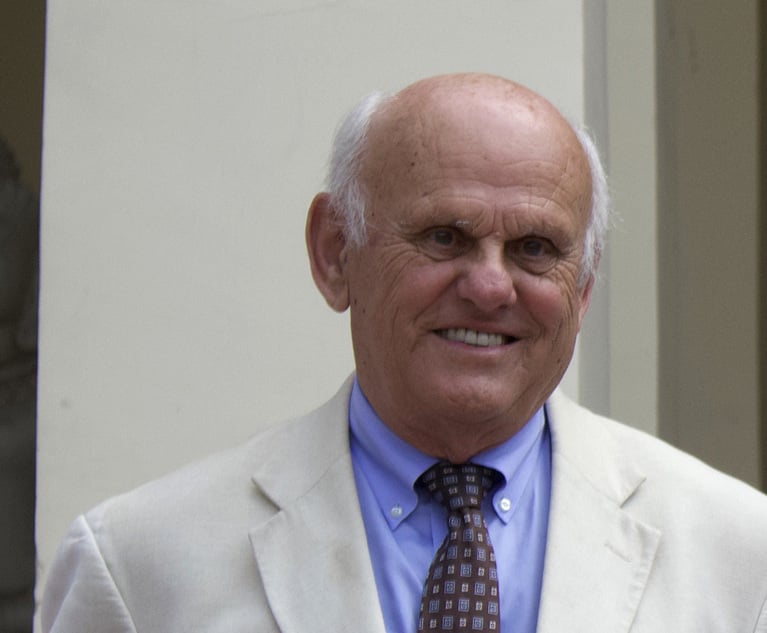Brooklyn Sees Significant Reduction in Pending Foreclosure Actions
Justice Lawrence Knipel said the sharp reduction came from his decision to concentrate the wave of foreclosure cases that washed over the court with three Supreme Court justices and a Civil Court judge.
January 31, 2018 at 05:42 PM
4 minute read

The state Supreme Court in Brooklyn, which leads New York City's five boroughs in total number of foreclosures, has reduced its backlog of foreclosure cases from more than 11,500 three years ago to about 6,500, the lowest point in the past decade.
Justice Lawrence Knipel, the administrative judge for the court's civil matters, said the sharp reduction came from his decision to concentrate the wave of foreclosure cases that washed over the court—which was previously spread among some 27 judges—to three Supreme Court justices and a Civil Court judge.
“I 100 percent attribute the reduction to the dedicated parts,” Knipel said.
While more judges were handling foreclosure cases under the old system, they would get thrown in the mix with other types of cases and would often get put on the “back burner,” Knipel said.
Among the four judges in Brooklyn assigned foreclosure cases, Brooklyn Supreme Court Justice Noach Dear, who handles cases dealing with owner-occupied properties, reduced his backlog from 5,400 cases in 2016 to 4,400 this year.
“This is made possible by giving cases individual attention, talking to all sides, and strongly encouraging settlement,” Dear said in an email. “In addition, I welcome the 'friend of the court' who assists pro se litigants with settlement negotiations.”
During that timeframe, the caseload for Brooklyn Supreme Court Justice Mark Partnow, who handles cases involving properties not owner-occupied, fell from 3,400 to 1,400. Civil Court Judge Harriet Thompson whittled her caseload down from 500 to just more than 100.
The team of foreclosure judges previously included Brooklyn Supreme Court Justice Peter Sweeney, who took on the longest-running cases filed with the court, some of which dated back a decade.
But Knipel has taken Sweeney's place among the foreclosure judges and reassigned Sweeney to a trial part. The backlog for the part over which Knipel now presides has shrunk from 2,000 cases to 650.
According to PropertyShark, there were 827 foreclosed homes put up for auction in Brooklyn in 2017, which was double the number recorded for the previous year and the highest rate for the five boroughs.
Though Brooklyn leads the city in total foreclosures, according to figures from RealtyTrac, it is second to Staten Island in terms of foreclosures per housing unit. In Brooklyn, there was one foreclosure per 2,656 units in December, compared with one foreclosure per 958 units on Staten Island.
When Knipel was appointed as administrative judge for civil matters in Brooklyn in 2013, he said there were more than 12,000 foreclosures in the backlog. He said the backlog is now smaller than it's been since before the financial crisis hit in 2008. There were roughly 7,500 cases in the backlog prior to the recession.
While Knipel credits the drop to his decision to consolidate cases, the move raised concerns among homeowners' attorneys, who feared shifting caseload to a handful of judges would lead to a less-individualized approach by the courts.
Homeowners' concerns with Knipel's tactics were again piqued last year when the court arranged for a mass purge of more than 1,600 cases.
Jacob Inwald, director of foreclosure prevention for Legal Services NYC, said it is “understandable and appropriate” for courts to take steps to reduce backlogs, but added he is concerned when courts take a single-minded focus on clearing their calendars rather than adjudicating cases fairly.
“You have to do it in a careful way,” Inwald said. “If there are things going on in that case that the court is not aware of, or if there are counterclaims in the case, you can't just dismiss a case a leave the defendant's counterclaim in some kind of black hole.”
Inwald said the backlog reduction in recent years is also driven by the borough's red-hot real estate market.
Plaintiffs now have more opportunities to reap profits from properties in Brooklyn's gentrifying neighborhoods than they did four or five years ago, Inwald said, and thus have more incentive to pursue cases to their disposition rather than let them languish.
With regard to Inwald's assessment, Knipel said that gentrification in the borough may have effected foreclosure activity in the courts “to an extent,” but noted that foreclosure activity tends to be higher in neighborhoods like East New York and Canarsie, than rapidly-gentrifying neighborhoods like Williamsburg and Bushwick.
This content has been archived. It is available through our partners, LexisNexis® and Bloomberg Law.
To view this content, please continue to their sites.
Not a Lexis Subscriber?
Subscribe Now
Not a Bloomberg Law Subscriber?
Subscribe Now
NOT FOR REPRINT
© 2025 ALM Global, LLC, All Rights Reserved. Request academic re-use from www.copyright.com. All other uses, submit a request to [email protected]. For more information visit Asset & Logo Licensing.
You Might Like
View All
Bankruptcy Judge Clears Path for Recovery in High-Profile Crypto Failure
3 minute read
US Judge Dismisses Lawsuit Brought Under NYC Gender Violence Law, Ruling Claims Barred Under State Measure

In Resolved Lawsuit, Jim Walden Alleged 'Retaliatory' Silencing by X of His Personal Social Media Account

'Where Were the Lawyers?' Judge Blocks Trump's Birthright Citizenship Order
3 minute readTrending Stories
- 1No Two Wildfires Alike: Lawyers Take Different Legal Strategies in California
- 2Poop-Themed Dog Toy OK as Parody, but Still Tarnished Jack Daniel’s Brand, Court Says
- 3Meet the New President of NY's Association of Trial Court Jurists
- 4Lawyers' Phones Are Ringing: What Should Employers Do If ICE Raids Their Business?
- 5Freshfields Hires Ex-SEC Corporate Finance Director in Silicon Valley
Who Got The Work
J. Brugh Lower of Gibbons has entered an appearance for industrial equipment supplier Devco Corporation in a pending trademark infringement lawsuit. The suit, accusing the defendant of selling knock-off Graco products, was filed Dec. 18 in New Jersey District Court by Rivkin Radler on behalf of Graco Inc. and Graco Minnesota. The case, assigned to U.S. District Judge Zahid N. Quraishi, is 3:24-cv-11294, Graco Inc. et al v. Devco Corporation.
Who Got The Work
Rebecca Maller-Stein and Kent A. Yalowitz of Arnold & Porter Kaye Scholer have entered their appearances for Hanaco Venture Capital and its executives, Lior Prosor and David Frankel, in a pending securities lawsuit. The action, filed on Dec. 24 in New York Southern District Court by Zell, Aron & Co. on behalf of Goldeneye Advisors, accuses the defendants of negligently and fraudulently managing the plaintiff's $1 million investment. The case, assigned to U.S. District Judge Vernon S. Broderick, is 1:24-cv-09918, Goldeneye Advisors, LLC v. Hanaco Venture Capital, Ltd. et al.
Who Got The Work
Attorneys from A&O Shearman has stepped in as defense counsel for Toronto-Dominion Bank and other defendants in a pending securities class action. The suit, filed Dec. 11 in New York Southern District Court by Bleichmar Fonti & Auld, accuses the defendants of concealing the bank's 'pervasive' deficiencies in regards to its compliance with the Bank Secrecy Act and the quality of its anti-money laundering controls. The case, assigned to U.S. District Judge Arun Subramanian, is 1:24-cv-09445, Gonzalez v. The Toronto-Dominion Bank et al.
Who Got The Work
Crown Castle International, a Pennsylvania company providing shared communications infrastructure, has turned to Luke D. Wolf of Gordon Rees Scully Mansukhani to fend off a pending breach-of-contract lawsuit. The court action, filed Nov. 25 in Michigan Eastern District Court by Hooper Hathaway PC on behalf of The Town Residences LLC, accuses Crown Castle of failing to transfer approximately $30,000 in utility payments from T-Mobile in breach of a roof-top lease and assignment agreement. The case, assigned to U.S. District Judge Susan K. Declercq, is 2:24-cv-13131, The Town Residences LLC v. T-Mobile US, Inc. et al.
Who Got The Work
Wilfred P. Coronato and Daniel M. Schwartz of McCarter & English have stepped in as defense counsel to Electrolux Home Products Inc. in a pending product liability lawsuit. The court action, filed Nov. 26 in New York Eastern District Court by Poulos Lopiccolo PC and Nagel Rice LLP on behalf of David Stern, alleges that the defendant's refrigerators’ drawers and shelving repeatedly break and fall apart within months after purchase. The case, assigned to U.S. District Judge Joan M. Azrack, is 2:24-cv-08204, Stern v. Electrolux Home Products, Inc.
Featured Firms
Law Offices of Gary Martin Hays & Associates, P.C.
(470) 294-1674
Law Offices of Mark E. Salomone
(857) 444-6468
Smith & Hassler
(713) 739-1250






